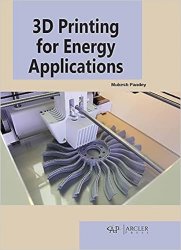 Название: 3D Printing for Energy Applications Название: 3D Printing for Energy Applications
Автор: Mukesh Pandey
Издательство: Arcler Press
Год: 2023
Страниц: 251
Язык: английский
Формат: pdf (true)
Размер: 18.97 MB
3D Printing for Energy Applications is a comprehensive and cutting-edge examination of how 3D printing can be used to fabricate complicated devices in the energy sector. The book discusses topics of additive manufacturing of functional materials that can be used in the energy sector. It examines both 3D printing processes and printable materials methods and their use in energy systems or devices. This book is divided into three parts that cover functional material's 3D printing before exploring the 3D printing of energy devices. It concludes with printing issues in complicated object creation. It also offers an intriguing outlook on the future of complex device 3D printing. Ideal for materials scientists, graduate students in material sciences, chemistry, and engineering will find 3D Printing for Energy Applications useful as a one-stop reference for present and future outlooks on 3D printing of high-value-added multifaceted devices.
This book contains eight chapters. Each chapter of the book explains the fundamental concept regarding a particular topic. Chapter 1 offers a detailed and thorough introduction of 3D printing technology, which contains additive manufacturing and its types along with its applications. Chapter 2 gives information on the application of 3D printing technology. Chapter 3 familiarizes the readers with the concept of Gas-Phase 3D printing of functional materials that contain a thorough background history so that readers can easily grasp these concepts. Chapter 4 discusses the 3D printing technology for the solar cell, including photovoltaic cell, solar concentrators, three-dimensional printing,3D printed solar cell and the Futuroscope.
3D printing, is also called additive manufacturing, is a technique for layering a three-dimensional object employing a computer-generated design. Chapter 5 thoroughly explains the 3D printed components for flexible supercapacitors along with their synthesis methods and characterization. Chapter 6 provides a detailed explanation of three-dimensional printing of piezoelectric materials and their different types (ceramics, polymers, pottery polymers), plus the concept of poling is also explained in this chapter. Chapter 7 focuses on the three-dimensional printing of rechargeable Ed batteries and the required battery materials also; the Li-based 3D-printed materials for REBs are also explained thoroughly to understand readers and end with the applications. This ends with chapter 8 that provides information about the three-dimensional fuel cells, their efficiency, and future scope.
This book is an excellent resource for anyone attracted to energy 3D printing. The book is also a valuable textbook for graduate and undergraduate courses that seek to provide students with a complete understanding of 3D printed electronics foundations.
Скачать 3D Printing for Energy Applications
|